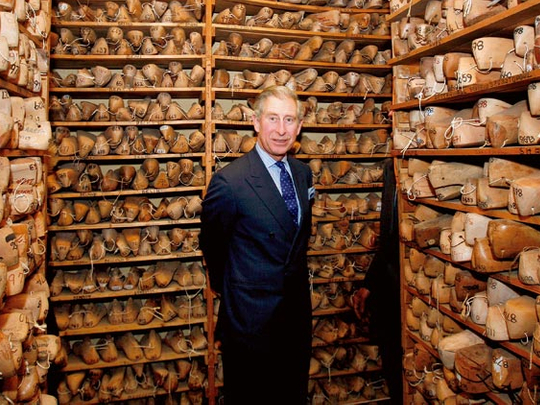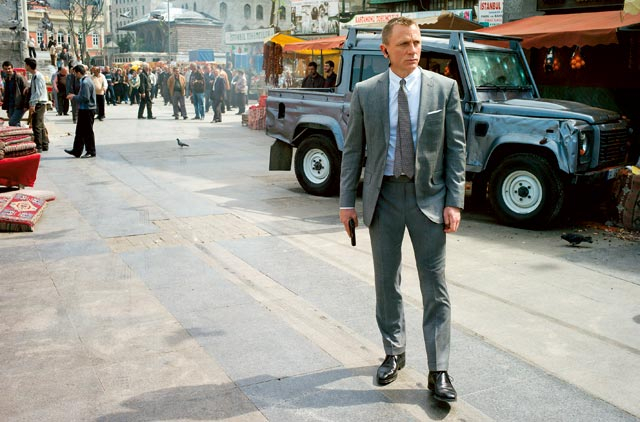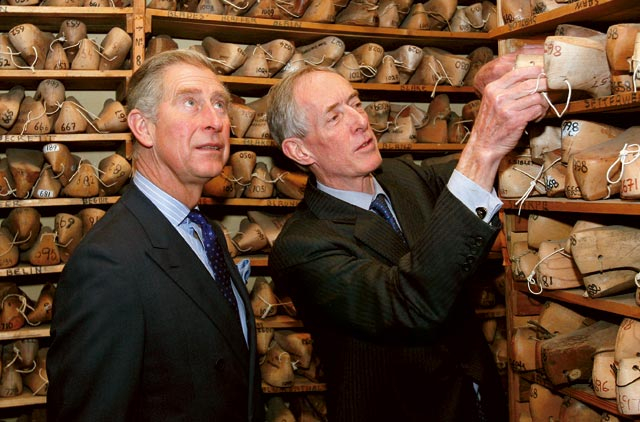
The concept of a shoe museum may seem a little odd, but to the town of Northampton in the UK, about 110 kilometres north-west of London, it is a way of highlighting its boot and shoemaking heritage. Even today, the town still has a high concentration of premium shoe brands, with names such as Tricker’s, Church’s, Grenson, John Lobb and Jeffery-West all made there. To those who know shoes, the ‘Made in Northampton’ mark has become a sign of prestige and quality, catering to everyone from members of the royal family to a certain fictional movie spy.
But how did this legacy come about? Rebecca Shawcross, shoe resources officer at the Northampton Museum, which has footwear dating back to ancient Egypt, believes it stems from the 14th century. “In the Middle Ages, Northampton was a busy market town,” she says, “and like any, it had a street of cordwainers [shoemakers], but the advantage here was that it was a stopping place on the road to London – royalty would even stop and purchase shoes, with King John dropping in to buy a pair around 800 years ago. Northampton had the raw materials needed for quality shoemaking too, such as cattle for the leather, oak bark for the soles and water to use in tanning.”
When laws were passed in 1401, and a Shoemakers’ Guild established by the government to regulate the trade, punishing anyone who did not meet its standards, Northampton’s reputation was elevated further, while its location and access to the capital meant that it was easy to sell all over the country. By 1650, the city’s shoe industry was booming, prompting author Thomas Fuller to write, “the town of Northampton may be said to stand chiefly on other men’s legs… the best boots in England are to be bought in Northampton.”
At this time, shoemaking was mainly carried out in small workshops, and it was men’s footwear that the city specialised in – women’s shoemaking required very different skills. The introduction of technology, and large, expensive machinery used for stitching, saw the building of factories, resulting in mass production – by 1836, one manufacturer, William Parker, was making 80,000 pairs of shoes a year. “In 1841, there were 1,821 shoemakers in Northampton,” says Rebecca, “and many of the town’s most famous brands were established at this time.”
The First World War was another boom time, with factories making boots for soldiers, but by the 1940s, things started to change. The availability of cheaper, synthetic materials and faster manufacturing processes in developing countries made it hard for the companies that specialised in high-quality leather footwear to compete. Many closed down, but a smaller market only helped to shine the spotlight on those that remained.
The city’s reputation even encouraged new companies to join the line-up - Jeffery-West, for example, was only established in 1987. When asked to define the kind of shoe made in Northampton these days, Rebecca does so with a smile. “Expensive,” she says. “They occupy a niche market that is appreciated the world over, particularly in Italy and Japan.”
It is not simply the price tag that defines a Northampton shoe, as many tend to employ age-old techniques, rarely seen elsewhere. “A pair of Oxford brogues from Church’s are made in the same way today as they were 100 years ago,” Rebecca says. “There are about 200 processes that go into making a pair of men’s shoes, from the person choosing the leather and the clicker who cuts out the leather upper, to the one who puts them in their protective shoe bag and boxes. Although machines are used, such as the sewing machine and lasting machine, all of them are still operated by hand. A firm like Edward Green still has hand-sewers making the shoes in the same way they would have 200 years ago. It’s a very skilled job.”
Rebecca believes there are other unique characteristics that make top-quality shoes stand out. “Most of the men’s footwear made here is Goodyear welted,” she says. “A welt is a strip of leather that is stitched to the upper and insole of a shoe, as an attach-point for the sole. The space enclosed by the welt is filled with cork or another material, usually either porous or perforated for breathability, and the outside is both cemented and stitched to the welt. Shoes with other types of construction may have welts for appearance, but they serve little or no structural purpose.”
So it is no ordinary level of craftsmanship, quality and experience that goes into making a pair of Northampton shoes, and while they are expensive, they are certainly built to last. But as Rebecca points out, historically, the longevity of a pair of men’s shoes has been vitally important, which is a perhaps another reason that the city’s brands excelled.
“In comparison to women’s shoe fashions, men haven’t fared so well,” she says. “Though this is put down to the fact that even wealthy men in the past would have probably only had one pair that they wore until they fell apart. It has probably always been thought that men don’t need a vast wardrobe of shoes, unlike women. In simplistic terms, many men can happily get by with a black pair and a brown pair.”
Walking around the Northampton Museum, it becomes evident that one Northampton-based manufacturer is looking to buck the trend. Jeffery-West, the focus of a special exhibition currently being held there, was founded in the 20th rather than 19th century, and while leaning towards the build quality of its peers, still yearns for something different. “Since it was founded, the idea behind Jeffery-West has been to combine cutting-edge styles with that history and tradition,” says Rebecca. “Endurance is a key factor, so the footwear is extremely well made, but so is elegance and flamboyance, with an array of leathers and colours uncommon to men’s shoes. This approach has led to Jeffery-West collaborating with artists and companies that share their ideals, creating limited edition footwear and accessories. These have included Norton Motorcycles, furniture designer Mark Brazier-Jones, street artist Paul Insect, and illustrator and musician Vince Ray.”
Moving from the traditional styles of Northampton’s past to these bright, bold designs could be interpreted as a peek into its future. But that doesn’t mean the other companies will follow suit, as they are doing just fine on reputation alone – Tricker’s, for example, holds a royal warrant, and is said to be a favourite of Prince Charles, while Church’s and John Lobb are among those to have helped style James Bond in the movies.
The museum is not just about tracing the timeline of Northampton’s shoemaking. It houses the biggest collection of shoes anywhere in the world, with more than 12,000 samples. If you want to see the drumming shoes worn by Charlie Watts of the Rolling Stones, or football boots worn by David Beckham, then this is the place.
While there may be deviations, it all comes back to several core principles, all of which are evident in Northampton’s shoe industry. “I think you perhaps have two strands; men who are interested in a classic traditional look, so expensive, long-lasting shoes, timeless, something to hand on, quality over quantity,” says Rebecca. “And men interested perhaps more in fashion footwear, dictated by current trends and changes in style, and of course trainer obsessives. Maybe it comes from age. You start being fashionable and then go down the classic route – so you always end up looking for quality. Good shoes are expensive.”
Shoe brands still based in the city:
Church’s
Founded in 1873 by Thomas Church and his three sons, the company was one of the first to make the Adaptable – a shoe with both a
left and right fitting. The company
is now owned by Prada.
www.church-footwear.com
Crockett & Jones
Seen on Daniel Craig’s feet in the most recent Bond film, Skyfall. Founded in 1879 by James Crockett and his brother-in-law Charles Jones, it is still managed by the same family to this day.
www.crockettandjones.com
Edward Green
Began making shoes in a small factory in Northampton in 1890. Today, there are both ‘ready to wear’ and ‘made to order’ pairs, created from the finest calfskin over several weeks.
www.edwardgreen.com
Grenson
Founder William Green created the first factory in the world to incorporate the Goodyear-welt shoemaking method. It also made boots and shoes for soldiers during the Second World War.
www.grenson.co.uk
Jeffery-West
Childhood friends Mark Jeffery and Guy West founded the brand in 1987, with a modern take on traditional design. Flamboyant, elegant designs and eye-catching colours make them stand out.
www.jeffery-west.co.uk
John Lobb
Now owned by Hermès, John Lobb is best known for its Double Monk-Strap shoes. The brand has been worn by Frank Sinatra, and also Daniel Craig in Quantum of Solace.
www.johnlobb.com
Tricker’s
Founded in 1829 by Joseph Tricker, the company uses only the finest materials – such as calf upper leather and oak bark tanned soles.
A favourite of Prince Charles’.
www.trickers.com














